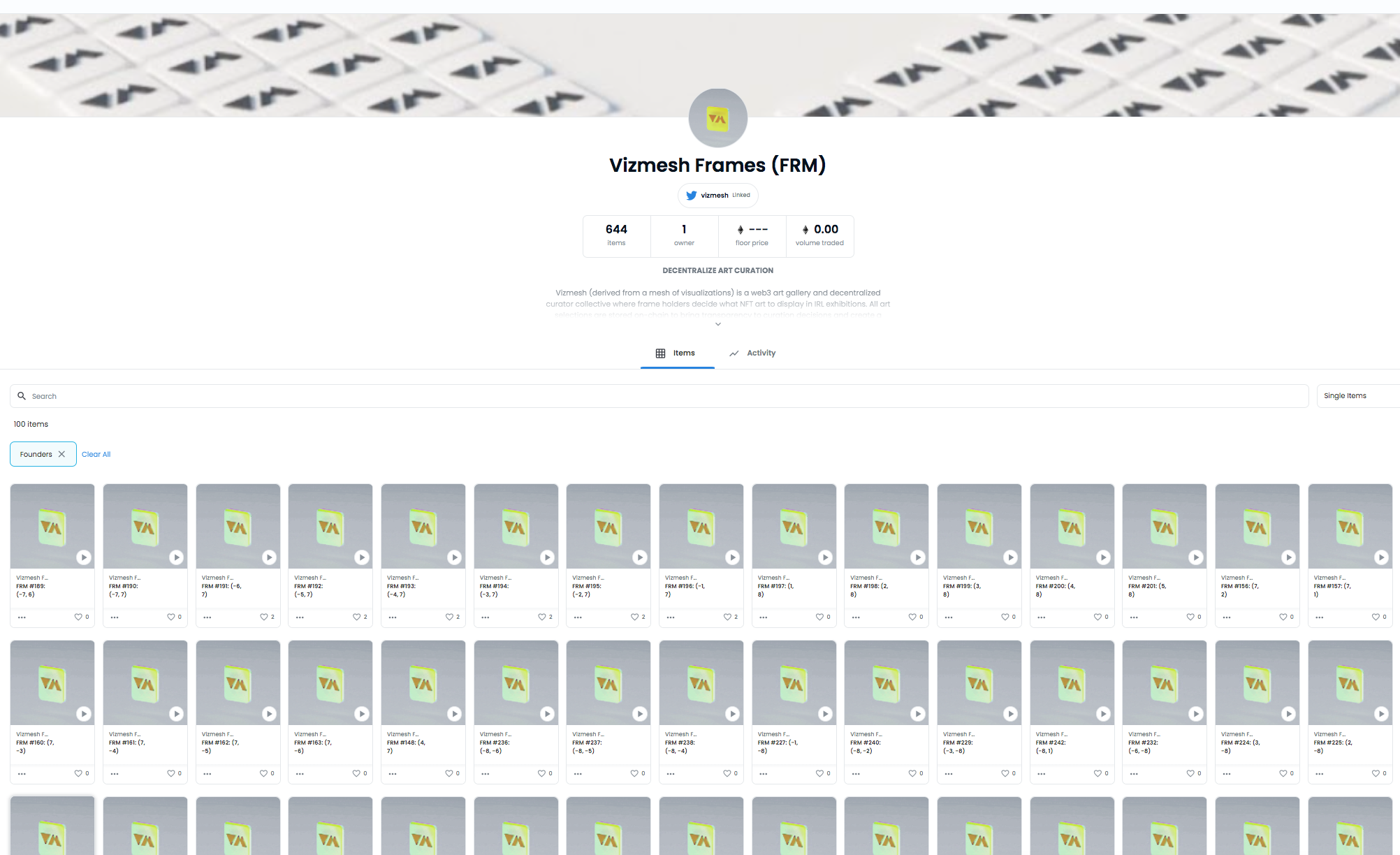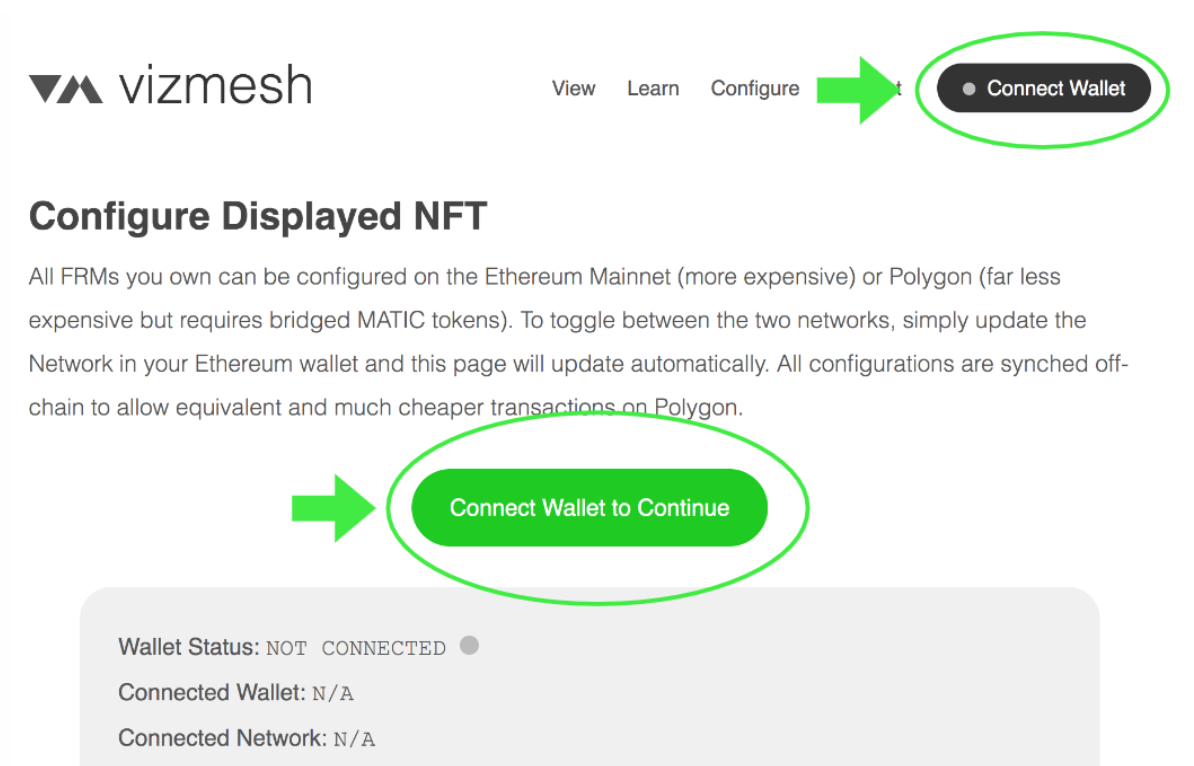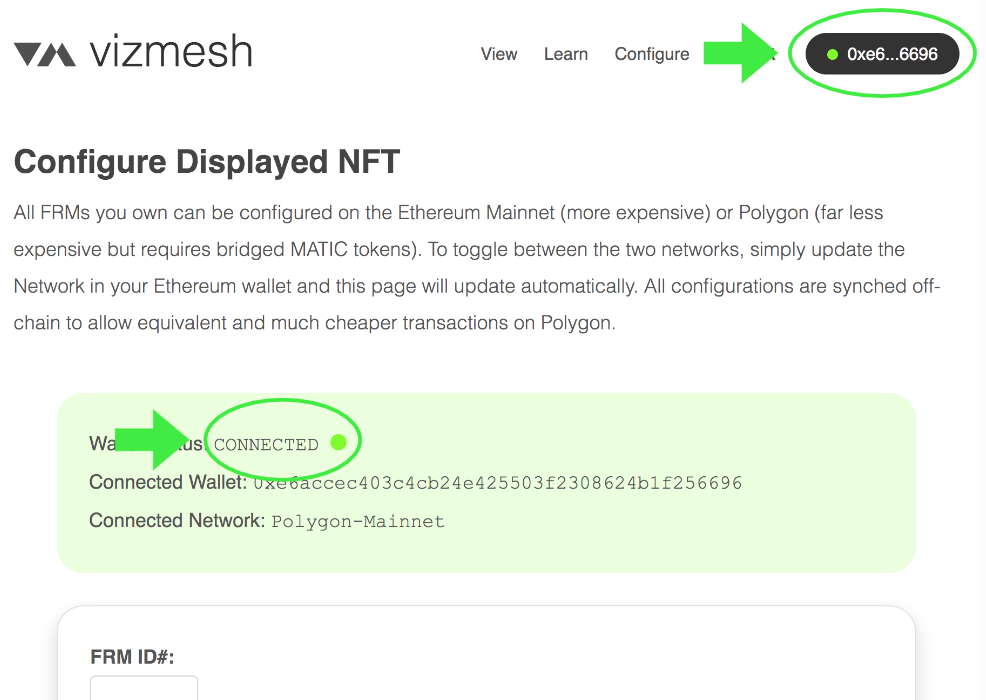Content Navigation
What Is Vizmesh?
Vizmesh is a blockchain-based NFT art gallery which is decentrally owned and curated. Units of Vizmesh are denominated in Vizmesh Frames (FRM) which can each display a single NFT and are limited in supply. FRM owners can configure their frames to display any NFT as many times as they want.
What Is a Frame (FRM)?
FRM stands for Vizmesh Frame, which is the smallest unit of Vizmesh. Each FRM has a unique (x,y) location and can display a single NFT, which is configured by its owner.
A Founders Edition FRM
What Is the Maximum Supply of FRM?
Even though the initial deployment of Vizmesh has 644 FRMs, the total supply is actually 10,000 to scale the system while maintaining scarcity. New editions of FRMs will be released organically as the need for exhibition funding and community growth are needed.
How Can I Get FRM?
FRMs can be purchased on the Vizmesh Frames page on OpenSea or received in the form of grants to artists and collectors.

The Vizmesh Frames page on OpenSea.
Apply For a Grant
If you are interested in applying for a grant to receive a free FRM and a micro grant of $500, please email sooyoung@vizmesh.io with a link to your NFT portfolio, social media profile and a short essay describing why you believe your unique approach to NFTs adds value to the space.
Official Links and Smart Contract Addresses
The following is a list of official links and smart contract addresses for the Vizmesh Platform. Always verify the smart contract address both on this page and on social media before signing ANY transactions.
Connecting MetaMask to Vizmesh Smart Contract
To modify an FRM you own, it is necessary to connect to the underlying Vizmesh smart contract. To do this, first navigate to the Vizmesh Configure Page. Next, click either of the "Connect Wallet" buttons shown below:

How to locate the "Connect to Web3" button.
Once connected under your Ethereum wallet address, you will see your connection status change on the configuration page and configuration status icon in the top-right corner. After making this connection, you will be able to update your FRM to display any NFT you choose.

How to verify a successful Web3 connection.
NFT Terminology, Jargon and Acronyms
In the NFT Art universe, there are many terms and acronyms to be aware of that will be used throughout this documentation. It is recommended to start here before going further.
What Is Vizmesh?
Vizmesh is a blockchain-based NFT art gallery which is decentrally owned and curated. Units of Vizmesh are denominated in Vizmesh Frames (FRM) which can each display a single NFT and are limited in supply. FRM owners can configure their frames to display any NFT as many times as they want.
What Is a Frame (FRM)?
FRM stands for Vizmesh Frame, which is the smallest unit of Vizmesh. Each FRM has a unique (x,y) location and can display a single NFT, which is configured by its owner.
A Founders Edition FRM
What Is the Maximum Supply of FRM?
Even though the initial deployment of Vizmesh has 644 FRMs, the total supply is actually 10,000 to scale the system while maintaining scarcity. New editions of FRMs will be released organically as the need for exhibition funding and community growth are needed.
How Can I Get FRM?
FRMs can be purchased on the Vizmesh Frames page on OpenSea or received in the form of grants to artists and collectors.

The Vizmesh Frames page on OpenSea.
Apply For a Grant
If you are interested in applying for a grant to receive a free FRM and a micro grant of $500, please email sooyoung@vizmesh.io with a link to your NFT portfolio, social media profile and a short essay describing why you believe your unique approach to NFTs adds value to the space.
Official Links and Smart Contract Addresses
The following is a list of official links and smart contract addresses for the Vizmesh Platform. Always verify the smart contract address both on this page and on social media before signing ANY transactions.
- Vizmesh Twitter: https://twitter.com/vizmesh
- Vizmesh Instagram: https://instagram.com/vizmesh
- Vizmesh OpenSea Page: https://opensea.io/collection/vizmesh
- Asset Smart Contract - Ethereum Mainnet: 0xFDf676eF9A5A74F8279Cd5fC70B8c1b9116b05CD
- Config Smart Contract - Ethereum Mainnet: 0xDDEfF1a494E464601A4AA76BB667E405e85c996F
- Config Smart Contract - Polygon Mainnet: 0x18d4Cf6eB2B0b2B2112a2e707D519c76Bf27d91e
Connecting MetaMask to Vizmesh Smart Contract
To modify an FRM you own, it is necessary to connect to the underlying Vizmesh smart contract. To do this, first navigate to the Vizmesh Configure Page. Next, click either of the "Connect Wallet" buttons shown below:

How to locate the "Connect to Web3" button.
Once connected under your Ethereum wallet address, you will see your connection status change on the configuration page and configuration status icon in the top-right corner. After making this connection, you will be able to update your FRM to display any NFT you choose.

How to verify a successful Web3 connection.
NFT Terminology, Jargon and Acronyms
In the NFT Art universe, there are many terms and acronyms to be aware of that will be used throughout this documentation. It is recommended to start here before going further.
- Crypto Currency: This is a digital currency that is maintained on a distributed public blockchain. For the context of this platform, the key crypto currency used is ETH, which is stored and transferred on the Ethereum Blockchain.
- Decentralized Application: Also known as DApps, decentralized applications are scripts that are cemented on the Ethereum Blockchain (there are other decentralized application platforms, but Ethereum was the first of its kind and the most widely used). Users can interact with these applications in an anonymous way, similar to how crypto currencies allow anonymous transactions on their respective block chains. The key innovation of decentralized applications is that they allow programmable storage to be put on the blockchain, rather than just numbers representing crypto currency balances.
- Smart Contract: A smart contract is a script that can be deployed to the Ethereum Blockchain to create a decentralized application. Vizmesh has its own smart contract, which represents the foundation and storage layer of the Vizmesh decentralized application. Users can interact with the Vizmesh smart contract and others using identity management tools like MetaMask.
- Etherscan.io: Etherscan is an Ethereum blockchain explorer. It allows users to view ETH balances and interact with smart contracts deployed on the Ethereum blockchain. Etherscan is a well established and trusted platform. All Vizmesh transactions are handled directly on Etherscan to avoid the creation of an additional interaction layer (more interaction layers can create security and counterfeiting risks).
-
Ethereum Wallet: An Ethereum wallet is an application which allows you to verify your identity and interact with other participants on the Ethereum blockchain. An ethereum wallet is composed of a few main components:
- Accounts: Within each profile, you can create different accounts. This is similar to how in traditional banking you might have an investment account, a spending account and a savings account.
- Public Address: Each account will have a public address which is where participants in the Ethereum blockchain can send ETH or assign ownership of digital assets. Public addresses are safe to share with other participants (but NOT their corresponding private keys). Sharing a public address is similar to sharing your email address with people you want to communicate with.
- Private Keys: Private keys are what are used to verify your ownership of a public address. Private keys should never ever be shared with anyone.
- MetaMask: MetaMask is the most commonly used Ethereum wallet application and it is recommended to use on Google Chrome as an extension rather than the mobile app. Decentralized applications typically have a web front end, and the Chrome extension does a better job of connecting to those web-based decentralized applications than the mobile app.
- Non-Fungible: Something that is unique. Unlike crypto currencies that are uniformly valued, a non-fungible asset represents a single unique digital item.
-
NFT: A Non-Fungible Token (NFT) is a digital asset that is stored and tracked on a smart contract to represent any unique (non-fungible) thing be that art, collectibles, tickets, votes etc. Unlike ETH, which is a crypto currency, an NFT exists within the context of a smart contract and not the broader system. What this means is that the transfer of an NFT must be done within its originating smart contract context rather than the broader Ethereum Blockchain. An NFT is composed of several key pieces:
- Smart Contract: All NFTs have an originating smart contract. If you mint an NFT on Foundation.app, it is created and stored within the Foundation.app smart contract.
- Token ID: To establish the unique/non-fungible aspect, a unique token ID is given to the NFT. To uniquely identify an NFT, the following combination of information is needed: [Block Chain] + [Smart Contract Address] + [Token ID]. When you mint, buy or sell an NFT, you are handling this unique token.
- URI: Each token has a URI, or uniform resource identifier which points to the NFTs metadata. Each URI is typically a website URL which stores the underlying metadata.
- Metadata: An NFTs metadata is the text that describes the underlying asset. Some common examples of what NFT metadata stores: artist name, title, creation date, image/video URL, smart contract/token information, anything else the minting platform requires or what the artist adds. It is strongly recommended that metadata and underlying asset images are stored on IPFS.
- IPFS: The InterPlanetary File System allows users to store files on a distributed system at fixed addresses permanently. While not all NFTs have their metadata and underlying image/video on IPFS, it is strongly recommended that artists use NFT platforms that upload their metadata and underlying images/videos to IPFS to ensure the eternal storage of the underlying asset. To store the asset information on a centralized server (whether that is the minting platform’s server, AWS or Google), there is a risk that these businesses will fold and the underlying information will be lost. While it is unlikely Amazon or Google will go out of business, it would be easier for a government to shut down Amazon or Google than to delete a global distributed file system from the internet. IPFS uses the same distributed approach that Ethereum and other crypto currencies use to ensure it’s everlasting and permanent nature.
 vizmesh
vizmesh
 Updating...
Updating...